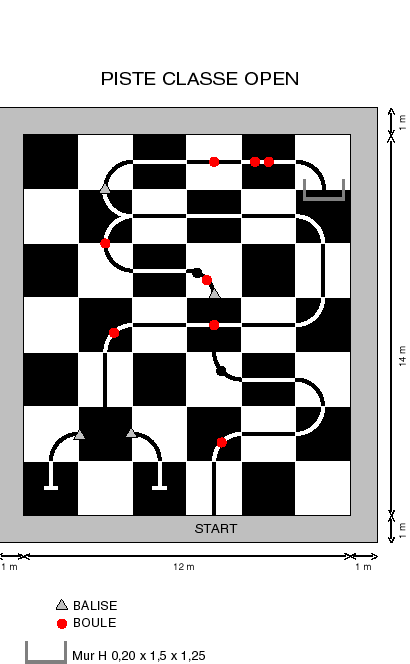 In the contest Open Class, where IST has competed so far, robots must be
built from scratch and are designed to follow a 5cm wide track painted on a chessboard-like surface,
composed of 2m side squares of alternating black and white colors. The track has the opposite color of
the corresponding background square and is composed of 2 meter straight lines and one-fourth of a
circle arc segments with 1 meter radius. There are track interruptions somewhere along the path,
obtained by replacing the corresponding background square by one with the same color but with no
track segment painted on. The robot must detect the interruption, and recover the track at the closest
segment, for instance by following a cylindrical retro-reflector, located 1 meter above the point where
the track resumes. An alternative track, starting 2 meters away from the main track and signaled by a
retro-reflector, must be taken by the robot, but in this case there are no interruptions in the main track
to trigger the decision of leaving it and following the retro-reflector. There are also track intersections.
The end of the main track is signaled by a T-shaped pattern. Furthermore, French billiard balls (200 g
weight and 61.5 mm diameter), of red and black colors, scattered along the track, must be collected
and discriminated by the robot. Black balls must be rejected and red balls must be transported until the
end. Every year, new challenges are added to the rules. In the 1998 competition, the robot had to detect
a black wall at the end of the alternative track and return along this track to the main track. The figure
shows the latest version of the contest challenges.
In the contest Open Class, where IST has competed so far, robots must be
built from scratch and are designed to follow a 5cm wide track painted on a chessboard-like surface,
composed of 2m side squares of alternating black and white colors. The track has the opposite color of
the corresponding background square and is composed of 2 meter straight lines and one-fourth of a
circle arc segments with 1 meter radius. There are track interruptions somewhere along the path,
obtained by replacing the corresponding background square by one with the same color but with no
track segment painted on. The robot must detect the interruption, and recover the track at the closest
segment, for instance by following a cylindrical retro-reflector, located 1 meter above the point where
the track resumes. An alternative track, starting 2 meters away from the main track and signaled by a
retro-reflector, must be taken by the robot, but in this case there are no interruptions in the main track
to trigger the decision of leaving it and following the retro-reflector. There are also track intersections.
The end of the main track is signaled by a T-shaped pattern. Furthermore, French billiard balls (200 g
weight and 61.5 mm diameter), of red and black colors, scattered along the track, must be collected
and discriminated by the robot. Black balls must be rejected and red balls must be transported until the
end. Every year, new challenges are added to the rules. In the 1998 competition, the robot had to detect
a black wall at the end of the alternative track and return along this track to the main track. The figure
shows the latest version of the contest challenges.
The main objective of the competition is to complete the trajectory in the minimum possible time, with complete robot autonomy. Incorrect behavior (e.g., red balls not collected, black balls not rejected, interruptions not taken, non-stopped vehicle after the final 'T') are converted into time penalizations and added to the final traversing time. There is also a white ball, whose location on the chessboard can be decided by the team. Shooting this ball, towards a hole located on a predefined spot, grants a time bonus. This is meant to reward robots that follow the track very accurately, so that their trajectory is predictable and the correct place for the white ball can be determined a priori, as long as the robot has some device to “shoot'” the ball. The competition is an important local media event, implying that the robot must handle an environment full of random camera flash-lights, video cameras and overhead projectors, as well as irregular illumination conditions.
This project started in 1994, when 3 final year undergraduate students, challenged by an article in a Portuguese newspaper covering the 1st edition of the contest, proposed, as their final year project, to build a small autonomous mobile robot for the 2nd edition. From then on, three other robots were built for the 3rd to 5th editions. The experience gained from each participation has been important to prepare the following one. Some sub-systems have been used for two years now, since they proved to adequately perform their job, others have been modified every new year, either because we believe that the correct solution was not reached yet and/or because innovation is our main goal, and new sensors, kinematic structures and others have been modified just for the sake of comparing alternative ways of solving the same problem.
|
|
|
|
|
|